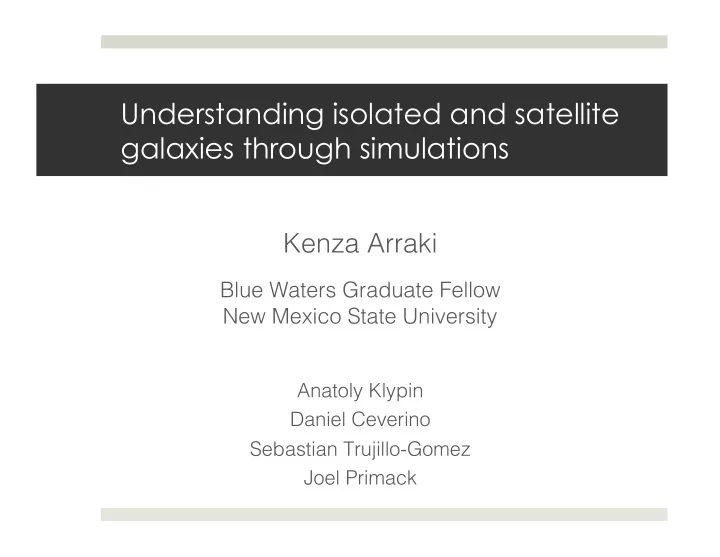

Understanding isolated and satellite galaxies through simulations Kenza Arraki � Blue Waters Graduate Fellow � New Mexico State University � Anatoly Klypin � Daniel Ceverino � Sebastian Trujillo-Gomez � Joel Primack �
Understanding galaxy evolution M31 Robert Gendler
Key Challenges � Understanding galaxy evolution requires: � large volume � high spatial resolution � long time span � good time resolution � following of dark matter particles � creation of stars and treatment of feedback � following gas flows � Understanding dwarf galaxy evolution requires: � even higher spatial resolution � large, well resolved volumes
Oliver Han, Tom Abel Stanford/KIPAC
Ken Crawford (Rancho Del Sol Obs.)
Why it Matters � Still are discrepancies between theory predictions and observations on small (galaxy) scales � Gain a better understanding of: � how dwarf galaxies build up their mass � how many satellite dwarf galaxies there are � morphological types of dwarf galaxies as evolution � how satellite and isolated dwarf galaxies differ � what dwarf galaxies central densities depend on � how dwarf galaxies impact their host galaxy � where the other 50% of gas mass is around our galaxy � what observations are required to find this gas
NASA, ESA, and T. Brown and J. Tumlinson (STScI)
Richard Powell
Project Goals � Create galaxies that are: � realistic - match observations on a variety of tests � high resolution - able to examine these small scales � Use them to learn about dwarf galaxies � isolated and satellite galaxies � abundances � star formation rates � central densities � morphological changes � tidal disruption and mass loss � influence on gas around galaxies
Project Goals � Tools used to create simulations and use them to learn about dwarf galaxies � ART, an Adaptive Mesh Refinement (AMR) code � hydrodynamics + dark matter particles + star particles � star formation & stellar feedback (stellar winds, supernovae feedback, radiation pressure) � “Zoom-in” initial conditions � large simulation volume ~ 20 3 Mpc 3 boxes � high spatial resolution ~ 20 pc � long time span ~ 14 Gyrs � good time resolution ~ 1000 yrs
Accomplishments � Code development has produced significant increase in code speed � 25 initial conditions generated of massive galaxies with well resolved surrounding regions � Parameter tests of isolated dwarf galaxy � Created analysis routines and workflow � Completed analysis of a set of simulations run with our hydrodynamical code by Daniel Ceverino
Software Products � Hydrodynamical Simulation Code � New feedback implementation for radiation pressure � Improvements to code efficiency � Full parallelization of density calculations � Better IO practices � Star particle resampling � Different refinement schemes � Analysis Workflow � Workflow for Rockstar halo finding algorithm (Peter Behroozi) � Fortran profiling and particle finding code � Python plotting and analysis routines � yt + ART compatibility
VELA Simulation Suite Analysis Run by Daniel Ceverino hydrodynamical ART code Box length = 20 /h Mpc DM mass = 8x10 4 M sun Resolution = 17 pc # cells = 67 million # particles = 30 million Stellar winds Supernovae feedback Radiation pressure ( τ IR =0)
VELA Simulation Suite Analysis 10 VELA host galaxies Results from redshift one Possible MW progenitors M vir = 2x10 11 – 1.2x10 12 M sun No specific environmental selection M star = 6x10 9 – 8x10 10 M sun Range of merger histories and M vir R vir = 92 – 147 kpc Density � Temperature � Metallicity �
VELA Simulation Suite Analysis Distribution of galaxies around main halo • Red “x” marks the R vir � center of main halo • Red circle marks the ‘edge’ of the main galaxy • Blue dots are luminous dwarf galaxies • Black dots are dwarf galaxies without any stars (dark galaxies)
Future Work � Run the 25 new initial conditions with our improved code � Volume = 100 3 Mpc 3 � Dark matter particle mass = 1.5x10 5 M sun � Physical resolution = 40 pc � Produce 500 outputs per simulation (a=0.002) � Update workflow to include time series analysis � Run workflow on simulations � Select isolated and satellite dwarf galaxies � Compare with observations of halo mass – stellar mass, star formation rates, abundance of satellites, merger rates, tidal stripping, luminosity function, circumgalactic medium, metallicity, central density, etc.
Acknowledgements � Blue Waters Graduate Fellowship � Steven Gordon, Bill Kramer, Jing Li, Craig Steffen � Anatoly Klypin � Daniel Ceverino and Sebastian Trujillo-Gomez � Matt Turk
Recommend
More recommend